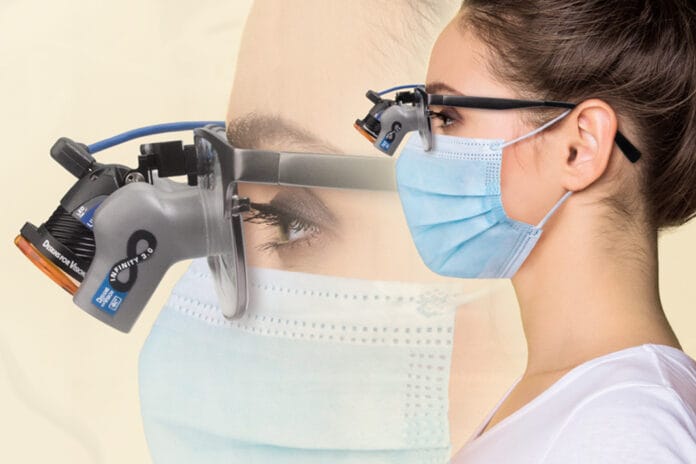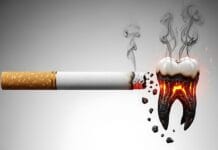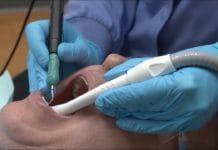Test Your Ergonomics Knowledge
Disclosure: This quiz is sponsored by Designs for Vision as part of our sponsored partner program.
Get a free, no-obligation, 60-day trial of Design for Vision's ergonomic-friendly Infinity VUE™ Loupes here.
Now lets test your ergonomics knowledge!
1. Instruments with smaller handle diameters reduce the hand muscle load and pinch force. Knurled handles increase tactile sensation and reduce pinch grip.
“Instrument diameters range from 5.6 to 11.5mm; larger handle diameters reduce hand muscle load and pinch force. A round handle, compared to a hexagonal handle, will reduce muscle force and compression. Lightweight instruments also reduce muscle workload and pinch force. Balance is important to reduce hand muscle fatigue; fulcruming on a third digit rest compared to a fourth digit rest does not engage the wrist as much while guiding and positioning the instrument or handpiece. Knurled handles such as diamond shaped or crisscross patterns serve to reduce pinch grip due to increased tactile sensation. Sharp instruments are essential for effective and efficient patient care.”
Hatfield, S. (2020, October 29). Loupes: Dentistry Doesn’t Have to be a Pain in the Neck. Today’s RDH. https://www.todaysrdh.com/loupes-dentistry-doesnt-have-to-be-a-pain-in-the-neck/
Jodalli, P.S., Kurana, S., Shameema, R.M., et al. Posturedontics: How does dentistry fit you? Journal of Pharmacy & BioAllied Sciences. 2015; 7(Suppl 2): S393-S397. https://www.ncbi.nlm.nih.gov/pmc/articles/PMC4606627/
2. Working posture is the main risk factor for developing musculoskeletal disorders in dental professionals.
Dental professionals are highly vulnerable to musculoskeletal diseases (MSD). MSDs are the #1 reason for early retirement among dental professionals.1 This is likely due to the frequency dental professionals is in a sitting posture. The curvature of the spine and head and pelvis position are crucial components for proper ergonomics when in a sitting position. Improper sitting position and working posture is the main risk factor for developing MSDs.2
1. Gupta, A., Bhat, M., Mohammed, T., et al. Ergonomics in dentistry. International Journal of Clinical Pediatric Dentistry. 2014; 7(1): 30-34. https://www.ncbi.nlm.nih.gov/pmc/articles/PMC4144062/
2. Gouvêa, G.R., Vieira, W.A., Paranhos, L.R. Assessment of the ergonomic risk from saddle and conventional seats in dentistry: A systematic review and meta-analysis. PloS one. 2018; 13(12): e0208900. https://www.ncbi.nlm.nih.gov/pmc/articles/PMC6296655/
3. Which of the following reduces MSD risk in dental professionals?
Alternating between standing and sitting will allow different muscle groups to work, providing rest for other muscle groups. Subtle changes in foot position shift the workload in the lower back, allowing tissue replenishing of nutrients to the soft tissues and repair. Repositioning patients is a simple task that reduces strain on the back and neck, also engaging different muscle groups and allowing for rest and repair in other muscle groups throughout the working day.
Chopra, A. Musculoskeletal Disorders in Dentistry – A Review. JSM Dent. 2014; 2(3): 1032. https://www.jscimedcentral.com/Dentistry/dentistry-2-1032.pdf
4. Musculoskeletal disorders in dentistry often begin with fatigue of the postural stabilizing muscles of the trunk and shoulders.
“Musculoskeletal disorders in dentistry often begin with fatigue of the postural stabilizing muscles of the trunk and shoulders. As these muscles fatigue, operators tend to slump into poor posture, setting the stage for injuries. Hygienists should perform specific strengthening exercises for the trunk and shoulder girdle to enhance the health and integrity of the spinal column, maintain good overworking posture, and optimize the function of the arms and hands to help prevent injuries.”
Hatfield, S. (2020, October 29). Loupes: Dentistry Doesn’t Have to be a Pain in the Neck. Today’s RDH. https://www.todaysrdh.com/loupes-dentistry-doesnt-have-to-be-a-pain-in-the-neck/
5. Yoga is one of the most effective modes of physical activity for reducing and preventing musculoskeletal pain. Integrating just 30 minutes of moderate physical activity daily helps address the static muscle activity of the legs, trunk, back, neck, and shoulders in a dental professional’s day.
When compared to other modes of physical activity, such as aerobics, brisk walks, and sports, yoga was more effective at reducing musculoskeletal pain. 89.5% of dental professionals that practiced yoga were free of musculoskeletal pain compared to 78.3% who practiced other exercise modes. Physical activity has been shown to promote overall health while being an effective preventive intervention for back, neck, and shoulder pain. It can also prevent and treat MSDs and stress among dental professionals.
Koneru, S., Tanikonda, R. Role of yoga and physical activity in work-related musculoskeletal disorders among dentists. Journal of International Society of Preventive & Community Dentistry. 2015; 5(3): 199-204. https://www.ncbi.nlm.nih.gov/pmc/articles/PMC4515802/
6. Hygienists wearing custom loupes maintained less overall trunk flexion while scaling. Extensive experience with loupes may also contribute to improved body posture when scaling without loupes for a short time.
Loupes have been shown to improve posture and reduce overall trunk flexion. Additionally, consistent use of loupes improves posture and has been shown to improve posture when needing to scale without loupes for a short time. This is because consistent use of loupes retrains the body to maintain a neutral position even in the absence of loupes.
Standard loupes are a great option, but even better are ergonomic loupes, such as Designs for Vision’s Infinity Vue Loupes. They allow for a wider range of vision, allowing the clinician to view an entire arch. This is due to their expanded field optics. Infinity Vue Loupes are available in 3.0x, 3.5x, and 4.5x magnification. Infinity Vue Loupes allow the clinician to keep the head, neck, back, and shoulders in a completely upright position, which is why the magnification is higher. Though this may seem high to some, your position is further from the patient, which will require higher magnification.
Ludwig, E.A., Tolle, S.L., Jenkins, E., Russell, D. Magnification loupes influence on neck and trunk flexion of dental hygienists while scaling-A pilot study. International journal of dental hygiene. 2021; 19(1): 106-113. https://pubmed.ncbi.nlm.nih.gov/33000517/
Designs for Vision. (n.d.). Infinity VUE Loupes. Reality Ratings & Review. https://www.designsforvision.com/REALITY/InfinityVUE-FirstLook.pdf
Get a free, no-obligation, 60-day trial of Infinity VUE™ Loupes here!
7. According to the Bureau of Labor Statistics (2013), the definition of MSDs includes which of the following?
According to the Bureau of Labor Statistics, in 2013, musculoskeletal disorder cases accounted for 33% of all worker injury and illness cases. The Bureau of Labor Statistics defines musculoskeletal disorders to include cases where the nature of the injury or illness is:
- Pinched nerve
- Herniated disc
- Meniscus tear: sprains, strains, tears
- Hernia (traumatic and nontraumatic): pain, swelling, and numbness
- Carpal or tarsal tunnel syndrome
- Raynaud’s syndrome or phenomenon
- Musculoskeletal system and connective tissue diseases and disorders
- When the event or exposure leading to the injury or illness is overexertion and bodily reaction (unspecified), overexertion involving outside sources, repetitive motion involving microtasks, other and multiple exertions or bodily reactions
- Rubbed, abraded, or jarred by vibration.
Hatfield, S. (2020, October 29). Loupes: Dentistry Doesn’t Have to be a Pain in the Neck. Today’s RDH. https://www.todaysrdh.com/loupes-dentistry-doesnt-have-to-be-a-pain-in-the-neck/
Ergonomics. (n.d.). United States Department of Labor: Occupational Safety and Health Administration. https://www.osha.gov/ergonomics
8. Which of the following conditions are associated with swelling of the tendons that run along the thumb side of the wrist, causing pain and tenderness often caused by overuse of the thumb and wrist?
De Quervain’s tenosynovitis is swelling of the tendons that run along the thumb side of the wrist. Pain is associated with swollen tendons being constricted by the sheath they run through. It is associated with overuse of the thumb and wrist as well as pregnancy and breastfeeding. Individuals with rheumatoid arthritis may be more susceptible, most commonly affecting people in their 40s and 50s. Women are more affected than men. An estimated 0.5% of men are affected, while 1.3% of women are affected.
Satteson, E., Tannan, S.C. De Quervain Tenosynovitis. [Updated 2022 Feb 22]. In: StatPearls [Internet]. Treasure Island (FL): StatPearls Publishing; 2022 Jan-. https://www.ncbi.nlm.nih.gov/books/NBK442005/
9. Compensatory workplace exercise consists of short active breaks, which involve discontinuing job tasks to exercise. This type of exercise is essential to workers' physical and mental health.
Types of workplace exercise can be categorized depending on the time of day.
Preparatory should be done at the beginning of the workday. This type of exercise should consist of stretching and/or warming up the muscles before starting tasks.
Compensatory exercise is short active breaks done throughout the workday, and the purpose is to help release tension and compensate for awkward postures.
Relaxation exercise should be done at the end of the workday; it is meant to relieve tension and fatigue. This could be in the form of yoga, Pilates, progressive muscle relaxation, and meditation.
Soares, C.O., Pereira, B.F., Pereira Gomes, M.V., et al. Preventive factors against work-related musculoskeletal disorders: narrative review. Revista brasileira de medicina do trabalho : publicacao oficial da Associacao Nacional de Medicina do Trabalho-ANAMT. 2020; 17(3): 415-430. https://www.ncbi.nlm.nih.gov/pmc/articles/PMC7195879/
10. MSDs account for nearly 70 million physician office visits annually in the U.S. and an estimated 130 million total health care encounters (including outpatient, hospital, and emergency department visits).
According to the Centers for Disease Control and Prevention, MSDs account for 70 million physician office visits and 130 million health care encounters annually in the U.S. Additionally, nearly one million people take time off from work to treat and recover from work-related MSD pain. MSDs estimated economic burden on the U.S. measured by compensation cost, lost wages, and lost productivity is between $45 and $54 billion a year.
Workplace Health Promotion: Work-Related Musculoskeletal Disorders and Ergonomics. (n.d.). Centers for Disease Control and Prevention. https://www.cdc.gov/workplacehealthpromotion/health-strategies/musculoskeletal-disorders/index.html












